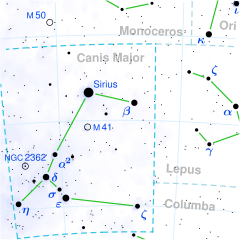| Observation data Epoch J2000 Equinox J2000 | |
|---|---|
| Constellation | Canis Major |
| Right ascension | 06h 58m 37.54876s[1] |
| Declination | –28° 58′ 19.5102″[1] |
| Apparent magnitude (V) | 1.50[2] |
| Characteristics | |
| Spectral type | B2 II[3] |
| U−B color index | –0.93[2] |
| B−V color index | –0.21[2] |
| Astrometry | |
| Radial velocity (Rv) | +27.3 km/s |
| Proper motion (μ) | RA: +3.24 mas/yr[1] Dec.: +1.33 mas/yr[1] |
| Parallax (π) | 7.57 ± 0.57 mas[1] |
| Distance | 430 ± 30 ly (132 ± 10 pc) |
| Absolute magnitude (MV) | –4.8[4] |
| Details | |
| Mass | 12 to 13.1[5] M☉ |
| Radius | 10.5[6] R☉ |
| Luminosity | 22,400+2,700 −2,400[5] L☉ |
| Surface gravity (log g) | 3.4±0.08[6] cgs |
| Temperature | 22,500±300[5] K |
| Rotational velocity (v sin i) | 25[7] km/s |
| Age | 17.5 – 19[6] Myr |
| Other designations | |
| Database references | |
| SIMBAD | data |
Epsilon Canis Majoris is a binary star system and the second-brightest star in the constellation of Canis Major. Its name is a Bayer designation that is Latinised from ε Canis Majoris, and abbreviated Epsilon CMa or ε CMa. This is the 22nd-brightest star in the night sky with an apparent magnitude of 1.50. About 4.7 million years ago, it was the brightest star in the night sky, with an apparent magnitude of −3.99.[8] Based upon parallax measurements obtained during the Hipparcos mission, it is about 430 light-years distant from the Sun.[1]
The two components are designated ε Canis Majoris A, officially named Adhara /əˈdɛərə/ – the traditional name of the system,[9][10] and B.
- ^ a b c d e Cite error: The named reference
aaa474_2_653was invoked but never defined (see the help page). - ^ a b c Ducati, J. R. (2002). "VizieR Online Data Catalog: Catalogue of Stellar Photometry in Johnson's 11-color system". CDS/ADC Collection of Electronic Catalogues. 2237: 0. Bibcode:2002yCat.2237....0D.
- ^ Cite error: The named reference
mnras410_1_190was invoked but never defined (see the help page). - ^ Cite error: The named reference
snowwas invoked but never defined (see the help page). - ^ a b c Cite error: The named reference
fossatiwas invoked but never defined (see the help page). - ^ a b c Cite error: The named reference
magneticwas invoked but never defined (see the help page). - ^ Cite error: The named reference
apj573_1_359was invoked but never defined (see the help page). - ^ Tomkin, Jocelyn (April 1998). "Once and Future Celestial Kings". Sky and Telescope. 95 (4): 59–63. Bibcode:1998S&T....95d..59T.
- ^ Kunitzsch, Paul; Smart, Tim (2006). A Dictionary of Modern star Names: A Short Guide to 254 Star Names and Their Derivations (2nd rev. ed.). Cambridge, Massachusetts: Sky Pub. ISBN 978-1-931559-44-7.
- ^ "Naming Stars (including "List of IAU-approved Star Names as of January 1st, 2021")". IAU.org. Retrieved 28 February 2021.
